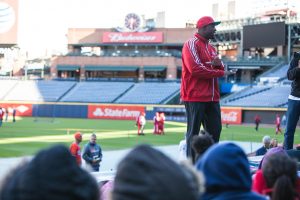It’s December, and we are in the second month of the building habits and strength phase. What’s a habit? A habit is an automatic reaction to a specific situation. If you cut a habit into thirds, it would consist of a cue, routine and a reward.

As a hitter facing a pitcher, a cue would represent a pitch type, location and velocity. A desired routine would be the perfect swing with the desired reward being a hit. Only elite hitters are able to match good swings as a routine on several varying pitch types, locations and velocities.
In this blog, some of my good friends, colleagues and clients are sharing some of their favorite and most effective drills for building habits and strength:
Marcus Smith (Le Moyen Owen College)
3 Plate Drill
This drill consist of three plates about 12 inches apart, vertical toward the batting practice (BP) pitcher with the L-Screen. The BP pitcher should be 60 feet from mound to home. He will maintain the same velocity throughout the drill. The batter will swing two times from each plate, moving closer to the BP pitcher. As the batter proceeds through each plate, the thrower’s velocity will change. Moreover, the batter has to make adjustments. For example, he should load and get his front foot down quicker. This drill also will improve your timing at the plate.
Ellis Prigge
Hitting Jack-It Drill
One of the most helpful drills I do to help build strength and habits is hitting with a bat jacket or a weight. This not only helps strengthen your forearms and biceps, but it also causes you to make adjustments, which in the future, will cause healthy habits (approach, contact and extension) for your swing. All you need is a bat, a few balls (tee is optional) and the weight for your bat.
Kwodwo Brannigan
TCB Hitting Video
The Total Control Ball is a very useful tool in building good habits and strength. The emphasis is placed on the hitter keeping his or her hands, in addition to the barrel of the bat, on the inner half of the ball while extending at the point of contact through the hitting zone. Continuous repetition of this helps strengthen the forearms, core, and hip flexor muscles. The drill, which needs limited space, can be used during soft or frontal toss and tee work.
Zack Phillips (zack.dbat@gmail.com)
Professional Hitting Instructor
Controlled Pepper Drill
Equipment: Baseballs, Bat, Hitting Jack-it (Optional)
You need a batting practice (BP) pitcher to run this drill. We see players play the game of pepper all the time, usually with a hitter choking up on the bat and slightly swinging down on the ball. The goal is to hit a one hop ground ball to four players that are around 10 feet away.
That is a great drill to build hand-eye coordination, but I like to use, what I call, controlled pepper. The BP pitcher should be around 20-25 feet away and throw a normal batting practice pitch. The hitter should take a full swing, but only at 10 percent. The goal is to also try and get a one hop ground ball back to the pitcher. This really helps build strength, as well as the habit of how to slow the swing of the bat. If you can consistently do this drill correctly and control your swing at 10 percent, imagine what you can do with a 100 percent swing.
Kory Warren
Color/Number Drill
Equipment: 18-27 baseballs, numbered 1-9, in red, blue, and green.
This two-person drill typically is done in the front toss position, but it also can be done in soft toss.
The hitter will watch the first five pitches and attempt to identify the color and number on the baseball. If the hitter has successfully identified those five colors and numbers, make him hit the baseball and identify color and number. Initially, the pitcher should try to put as little spin on the ball as possible to better help the hitter adjust his eye. As the hitter becomes more proficient in the drill, the pitcher can add some spin to the ball. Ultimately, the goal is for the hitter to dial in and successfully see the pitch. If he cannot identify the color or number (don’t guess), simply say, “I didn’t see it.”
This drill works on pitch tracking and pitch recognition. Many young hitters that do this drill for the first time realize how little they truly watch the ball as it approaches. Advanced hitters can use this drill for tracking the pitch, but as spin is added, the drill will help identify the spin and rotation on the ball, which can help them to recognize a pitch earlier and adjust accordingly.
Remember: Intelligence trumps being smart.
For more information, visit www.diamonddirectors.com today. Also, check out our Digital Magazine.
BIO
C.J. Stewart has built a reputation as one of the leading professional hitting instructors in the country. He is a former professional baseball player in the Chicago Cubs organization and has also served as an area scout for the Cincinnati Reds. As founder and CEO of Diamond Directors Player Development, CJ has more than 12 years of player development experience and has built an impressive list of clients, including some of the top young prospects in baseball today. If your desire is to change your game for the better, C.J Stewart has a proven system of development and track record of success that can work for you.

Leave a Reply